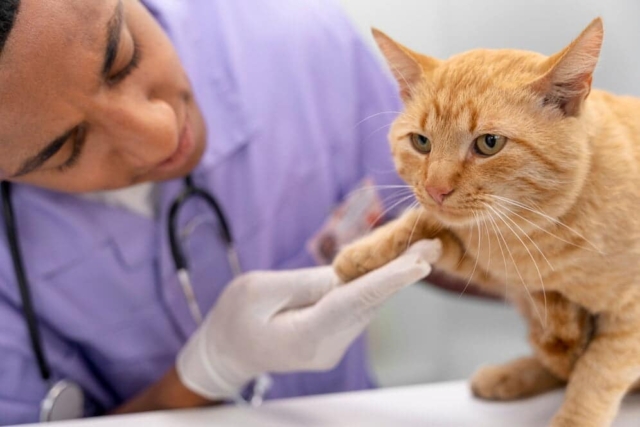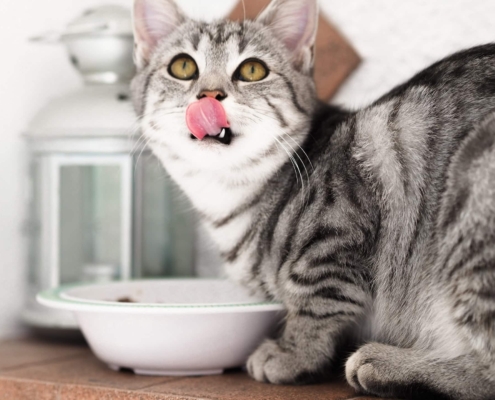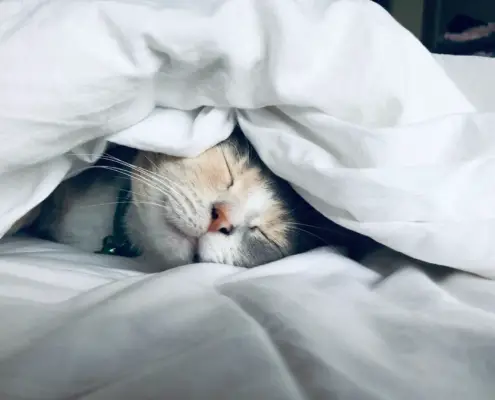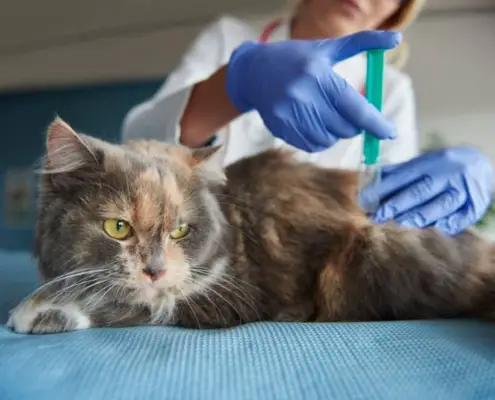
Maintaining good oral and dental health is crucial for the overall well-being of our feline friends. Just like humans, cats can develop various oral and dental issues that can impact their quality of life. Neglecting their oral hygiene can lead to discomfort, pain, and even more severe health problems. Therefore, it is essential for cat owners to understand the importance of oral/dental health and take necessary measures to keep their furry companions’ teeth and gums in top shape.
Oral and dental health issues in cats can go beyond bad breath. Poor dental hygiene can cause a buildup of plaque and tartar, leading to gum inflammation (gingivitis) and periodontal disease. These conditions can result in tooth decay, tooth loss, and infection, which can spread to other organs in the body, such as the heart and kidneys. By prioritizing their cat’s oral health, owners can prevent such complications and ensure their furry friend leads a happy and healthy life.
Regular dental check-ups are essential to catch any potential problems early on. A veterinarian can examine the cat’s teeth and gums, perform a thorough cleaning, and identify any signs of oral/dental issues that may require further attention. Additionally, cat owners should incorporate dental care into their daily routine to maintain optimal oral health for their feline companions. This includes brushing their cat’s teeth, providing dental-friendly food and treats, and using appropriate dental hygiene products.
Common Oral/Dental Issues in Cats
Cats are susceptible to various oral and dental health problems. One of the most prevalent issues is periodontal disease, which affects nearly 70% of cats over the age of three. Periodontal disease occurs when plaque and tartar accumulate on the teeth, leading to inflammation and infection of the gums. This condition can cause discomfort and pain for cats, making it difficult for them to eat and groom properly.
Another common oral/dental issue in cats is tooth resorption. This condition involves the progressive destruction of the tooth structure, leading to the erosion and eventual loss of the affected teeth. Tooth resorption can cause severe pain and discomfort for cats and often requires extraction of the affected teeth to alleviate their suffering.
Furthermore, cats can develop oral tumors, such as squamous cell carcinoma, which primarily affects the gums and oral cavity. These tumors can be aggressive and require prompt veterinary attention to determine the best course of treatment.
Symptoms of Oral/Dental Issues in Cats
Recognizing the signs of oral and dental issues in cats is crucial for early detection and intervention. Some common symptoms to look out for include bad breath, drooling, reluctance to eat or difficulty chewing, pawing at the mouth, bleeding gums, and loose or missing teeth. Cats may also exhibit behavioral changes, such as increased irritability or withdrawal, due to the discomfort caused by oral/dental problems.
It is important to note that cats are masters at hiding signs of pain or discomfort, so owners should pay close attention to any subtle changes in their behavior or eating habits. Regularly inspecting their cat’s mouth for any abnormalities and scheduling routine dental check-ups with a veterinarian are essential steps in maintaining their oral health.
Preventive Measures for Maintaining Good Oral/Dental Health in Cats
Prevention is key when it comes to maintaining good oral and dental health in cats. By implementing a few simple measures, cat owners can significantly reduce the risk of oral/dental issues and ensure their furry friends have healthy teeth and gums.
One of the most effective preventive measures is regular tooth brushing. Using a cat-specific toothbrush and toothpaste, owners can gently clean their cat’s teeth on a daily basis. It is important to introduce tooth brushing gradually to avoid stress or resistance from the cat. Additionally, providing dental-friendly food and treats can help reduce plaque and tartar buildup. These specially formulated products often have a texture that promotes chewing and helps remove plaque from the teeth.
Regular dental check-ups with a veterinarian are also crucial for preventive care. A professional dental cleaning can remove any stubborn plaque and tartar that cannot be addressed through regular brushing. During these check-ups, the veterinarian can also identify any potential issues and provide appropriate treatment or recommendations.
Dental Hygiene Products for Cats
When it comes to maintaining good oral health for cats, there are several dental hygiene products available in the market. These products are specifically designed to promote oral hygiene and reduce the risk of oral/dental issues.
Cat-specific toothbrushes and toothpaste are essential tools for daily tooth brushing. The toothbrushes are usually smaller and softer than human toothbrushes, making them more comfortable for cats. Cat toothpaste is specially formulated to be safe for ingestion and comes in flavors that appeal to cats, such as poultry or fish.
In addition to toothbrushes and toothpaste, cat owners can also consider using dental wipes or pads. These products can be used to wipe the cat’s teeth and gums and help remove plaque and food debris. Dental wipes are particularly useful for cats who are resistant to tooth brushing or for those who require additional cleaning between brushings.
Dental Cleaning Techniques for Cats
Proper dental cleaning techniques are crucial for maintaining good oral health in cats. The following steps outline an effective dental cleaning routine:
- Introduce tooth brushing gradually: Start by gently touching the cat’s lips and gradually progress to rubbing their teeth and gums. This allows the cat to become accustomed to the sensation and reduces the likelihood of resistance or stress.
- Use a cat-specific toothbrush and toothpaste: Apply a small amount of toothpaste to the toothbrush and gently brush the cat’s teeth in a circular motion. Focus on the outer surfaces of the teeth, as this is where plaque and tartar tend to accumulate the most.
- Be patient and gentle: It may take time for the cat to become comfortable with tooth brushing. Be patient, use a calm and soothing voice, and reward the cat with treats or praise after each successful brushing session.
- Incorporate other dental hygiene products: If the cat is resistant to tooth brushing, consider using dental wipes or pads to clean their teeth and gums. These products can be used as an alternative or in conjunction with tooth brushing.
- Maintain a regular dental cleaning schedule: Aim to brush the cat’s teeth at least three times a week, if not daily. Consistency is key in maintaining good oral health.
Dental Surgeries and Treatments for Cats with Oral/Dental Issues
In some cases, cats may require dental surgeries or treatments to address oral/dental issues. These procedures can range from simple extractions to more complex surgeries depending on the severity of the condition.
Extractions are commonly performed to address tooth resorption, severe periodontal disease, or dental trauma. The affected tooth is carefully removed under anesthesia to alleviate pain and prevent further complications.
In cases of oral tumors, surgical removal may be necessary to eliminate the tumor and prevent its spread. This procedure often involves the removal of the tumor and a portion of surrounding healthy tissue.
Additionally, cats with severe oral/dental issues may require root canal therapy or crown placement to save and restore a damaged tooth. These procedures are performed by veterinary dentists and require specialized training and equipment.
Home Remedies for Managing Oral/Dental Issues in Cats
While professional veterinary care is essential for managing oral/dental issues in cats, there are some home remedies that cat owners can try to alleviate discomfort and promote oral health. It is important to note that these remedies should not replace veterinary care but can be used as complementary measures.
One home remedy is the use of coconut oil for oral health. Coconut oil has antimicrobial properties that can help reduce plaque and improve gum health. Rubbing a small amount of coconut oil on the cat’s teeth and gums can provide some relief and promote oral hygiene.
Another home remedy is the use of natural dental rinses or herbal mouthwashes. These products often contain ingredients such as aloe vera or chamomile, which have soothing and anti-inflammatory properties. Adding a few drops of the rinse to the cat’s water bowl or applying it to their gums can help reduce inflammation and provide some relief.
When to Seek Veterinary Assistance for Your Cat’s Oral/Dental Health
While preventive measures and home remedies can help maintain good oral health in cats, it is important to seek veterinary assistance for any concerning symptoms or issues. A veterinarian is best equipped to diagnose and treat oral/dental problems in cats.
If a cat exhibits signs of oral/dental issues, such as bad breath, difficulty eating, or bleeding gums, it is important to schedule a veterinary appointment as soon as possible. Early intervention can prevent further complications and ensure the cat receives the appropriate treatment.
Additionally, routine dental check-ups with a veterinarian are essential for maintaining optimal oral health. A professional cleaning and examination can address any potential issues and help prevent the progression of oral/dental diseases.
Conclusion
Maintaining good oral and dental health is crucial for the overall well-being of cats. By understanding the importance of oral/dental health and implementing preventive measures, cat owners can ensure their furry friends have healthy teeth and gums. Regular dental check-ups, proper dental cleaning techniques, and the use of dental hygiene products are all essential components of a cat’s oral care routine. In case of oral/dental issues, seeking veterinary assistance is vital for accurate diagnosis and appropriate treatment. With proper care and attention, cat owners can help their feline companions enjoy a purr-fect dental health.
If you enjoyed my article, I would appreciate you sharing it with your network.

Sima Ndlebe
Sima writes for CatBuzz. He is interested in Cats, Health and Fitness, and Entrepreneurship.
Published: 11 October 2023
Related Articles
Disclaimer
The content found on CatBuzz.org is presented on an "as is" basis and is intended for general consumer information and education purposes only. Any utilization of this information is voluntary and solely at the user's own risk.
None of the articles or content should be regarded as, or used in place of, veterinary medical advice, diagnosis, or treatment. The information provided on the website is purely for educational and informational intentions and should not be considered a substitute for professional guidance from a veterinarian or other qualified expert. The articles are designed to inform consumers about veterinary healthcare and medical matters that may impact their cat's daily life. It should be noted that this website and its services do not constitute the practice of any form of veterinary medical advice, diagnosis, or treatment. CatBuzz.org explicitly disclaims any liability for any direct or indirect damages or losses that may arise from the use of or reliance on the information contained within the content.
Consumers must consult a veterinarian, veterinary specialist, or another qualified veterinary healthcare provider when seeking advice regarding their cat's health or medical conditions. It is important not to ignore, avoid, or postpone seeking medical advice from a veterinarian or other qualified veterinary healthcare provider solely based on information obtained from this website. If you believe that your cat may be experiencing a medical issue or condition, it is imperative to promptly contact a qualified veterinary healthcare professional.



